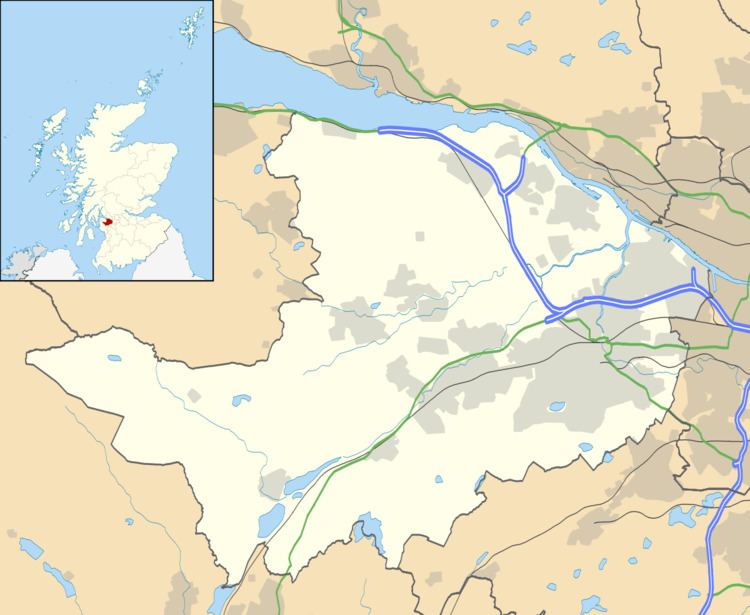OS grid reference NS387655 Post town BRIDGE OF WEIR Population 4,635 (2001) Dialling code 01505 | Sovereign state United Kingdom Postcode district PA11 Local time Friday 10:41 AM | |
 | ||
Weather 2°C, Wind NE at 6 km/h, 94% Humidity | ||
Bridge of weir tr
Bridge of Weir is a village within the Renfrewshire council area and wider historic county of Renfrewshire in the west central Lowlands of Scotland. Lying within the Gryffe Valley and providing a crossing point for the River Gryffe, the village today serves largely as a dormitory settlement for nearby Glasgow and Paisley although it maintains a commercial centre of its own and some light industry.
Contents
- Bridge of weir tr
- Map of Bridge of Weir UK
- Alternative rock bridge of weird by ray alexander
- History
- Notable Bridge of Weir leather customers
- Governance
- Recreation
- Notable people
- References
Map of Bridge of Weir, UK
Alternative rock bridge of weird by ray alexander
History
Bridge of Weir was historically an area divided between the parishes of neighbouring Houston and Killellan and Kilbarchan on either side of the River Gryffe. Growing out of the lands of Ranfurly, mainly occupied by small farms, the name 'Bridge of Weir' is first recorded in the early 18th century before any village was built. The 'weir' is a reference to a salmon weir which used to be located on the Gryffe. An older name provided for the village is 'Port o'Weir', implying a river crossing; this name remained in some use even after the Bridge of Weir name had been adopted.
The bridge at Bridge of Weir was constructed at Burngill c.1770 and was considerably upgraded and widened in 1892 to allow for two-way traffic. It was finally demolished in 1964, with a more modern structure created. The bridge owes its construction to being on the route between the significant towns of Greenock and Paisley, with a Great Road constructed between the two in 1794. Also significant to the infrastructure of the emerging settlement was the construction of the Glasgow, Paisley and Ardrossan canal which, despite its name, was only constructed up to nearby Johnstone. The Johnstone to Bridge of Weir railway route was formalised on the 20 June 1864 and the Bridge of Weir railway station built. The line extended to Kilmacolm and onwards in 1869. This railway substantially altered the character of the village and contributed to its forthcoming affluence. The railway closed on 10 January 1983 and now forms part of the Clyde to Forth cycle route (National Cycle Route 75).
The first semblances of the village came to be with the rise of the West of Scotland cotton industry. From around 1793 the river Gryffe was being used to power numerous cotton spinning and blanket making mills. The most significant industry to emerge in the village was leather. At its productivity peak the small village supported three tanneries. The leather industry survives to this day, now on a single site, in the form of a highly successful, modern facility with four Queen's Awards for International Business.
In 1989, the benches of the British Parliament's House of Commons and House of Lords chambers in Westminster were reupholstered using Bridge of Weir leather.
Notable Bridge of Weir leather customers
Governance
Bridge of Weir is part of the council area of Renfrewshire, as well the historic county of Renfrewshire which has wider boundaries and retains some official functions, for example as a registration county and lieutenancy area.
For elections to Renfrewshire Council, Bridge of Weir is part of ward 10, named 'Bishopton, Bridge of Weir and Langbank', which elects three of Renfrewshire's forty councillors. These members are: Cllr Michael Holmes (Labour), Cllr Iain Langlands (Conservative) and Cllr Carol Puthucheary (SNP).
Bridge of Weir is also one of Renfrewshire's twenty-seven community council areas.
Recreation
Bisected by the River Gryffe, angling is available within the village. The river hosts brown trout, grayling and occasionally Atlantic salmon. Numerous outdoor pursuits are available at the nearby Clyde Muirshiel Regional Park. National Cycle Route 75 runs through the village.
The village is also known for its golf history. At one point there were five golf courses in the vicinity; today there are two remaining: the Old Course Ranfurly and the Ranfurly Castle golf clubs. There was a thriving ice hockey team from around 1895 and in 1935 were Scottish National League Champions.
Notable people
Leslie Green, a noted jurisprudential theorist was born there.
Notable sports persons include Wilbur Muirhead, owner of the aforementioned leather works factory (still run by his nephew Jonathan) was Captain of the Royal & Ancient Golf Club of St Andrews. Walter and Kenneth McLeod, brothers both of whom lived in Bridge of Weir their entire lives, were very well known amateur golfers. Wilma Aitken, renowned Scots Curtis Cup golfer and runner-up in the 1981 British Ladies Amateur, also hails from Bridge of Weir.
William Quarrier Kennedy born here.
